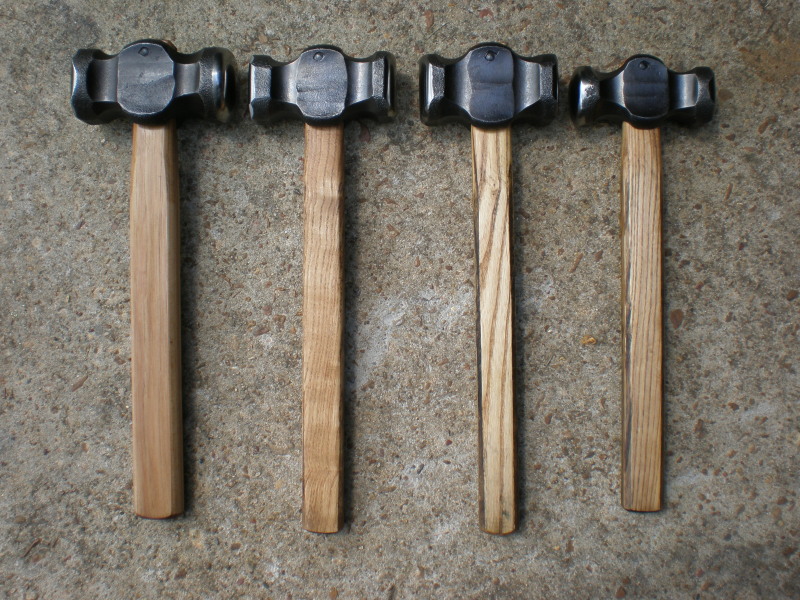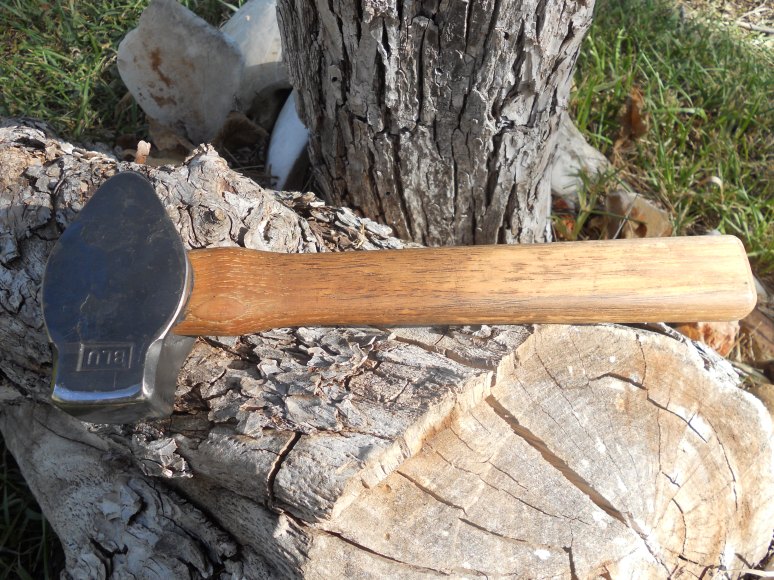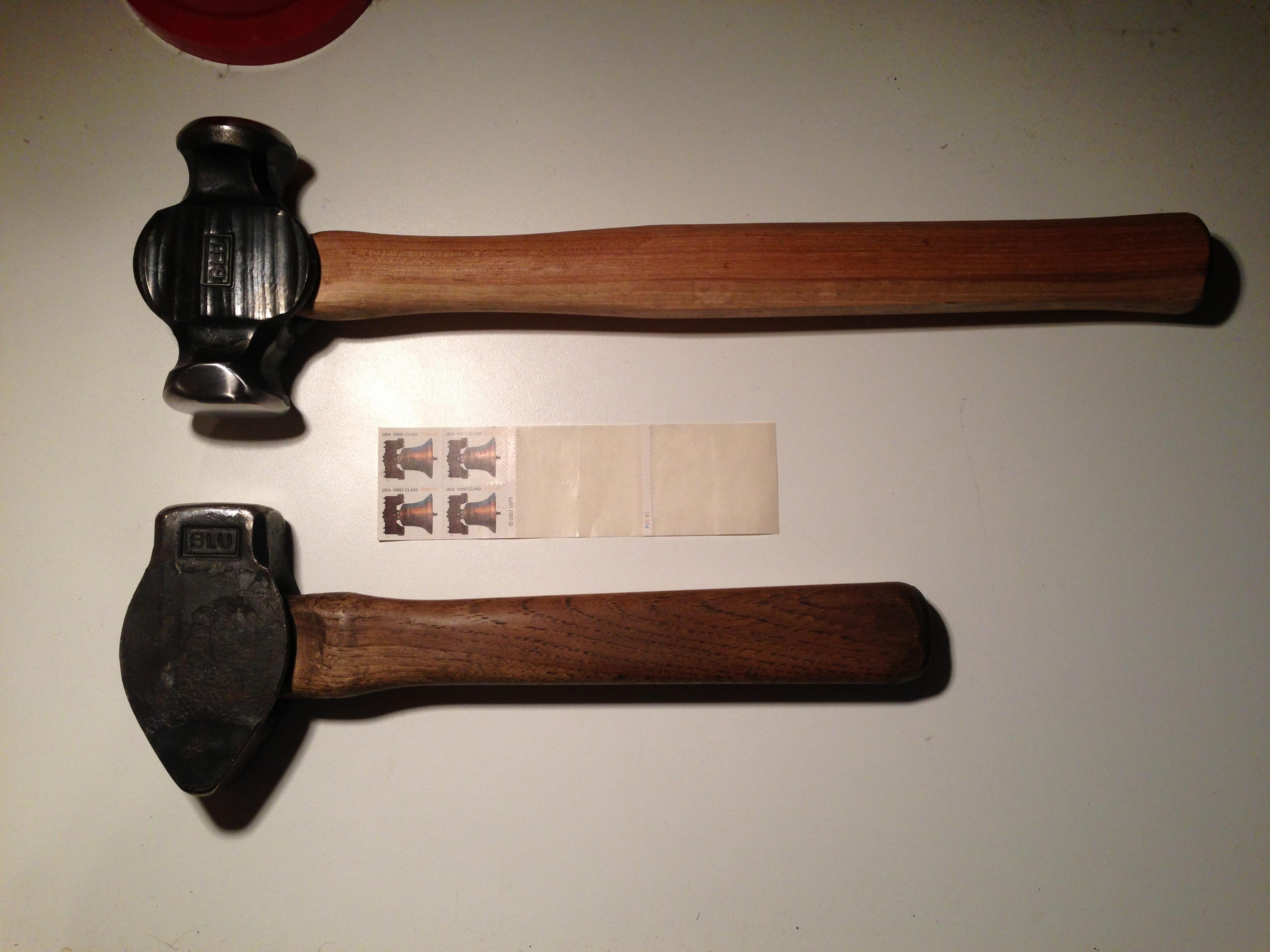 Needs Pictures: 0
Needs Pictures: 0
 Picture(s) thanks: 0
Picture(s) thanks: 0
Results 61 to 75 of 81
-
30th September 2014, 11:36 PM #61
-
30th September 2014 11:36 PM # ADSGoogle Adsense Advertisement
- Join Date
- Always
- Location
- Advertising world
- Age
- 2010
- Posts
- Many
-
27th December 2014, 01:09 PM #62
 Senior Member
Senior Member











- Join Date
- Apr 2013
- Location
- Canberra
- Posts
- 135

Hey Paul,
Sorry to dig up an old thread but I have just received two custom hammerheads I planned to handle with bull oak. Is your comment because it's a timber not suitable for hammers or because a knife does not make a good hammer?
Any help would be greatly appreciated. I know bugger all about timber (although a little more thanks to this thread.) I had planned to use gidgee as another option and now know that would not be ideal.
I wanted a very figured/patterned handle for these hammers.
Regards
Matt
Sent from my iPhone using Tapatalk
-
27th December 2014, 03:03 PM #63
 SENIOR MEMBER
SENIOR MEMBER











- Join Date
- May 2004
- Location
- Sth. Island, Oz.
- Age
- 64
- Posts
- 754

Bull oak is merely a name, not a species identifier.
Here in the Sth. Island, we would (roughly) identify "buloak" as from the Casuarina or Allocasuarina Genera, usually from the latter, as Casuarina is more commonly known in Tas. as "sheoak".
Just as E. regnans is known as swamp gum, stringy gum or mountain ash in different regions of Tas. & E. obliqua as brown-top, mountain ash or messmate, using common names to cover wildy different species (or even Genera) only leads to confusion.
Having said that, the Casuarina & Allocasuarina genera are taxanomically similar, having pronounced medullary rays in a similar manner to traditional northern hemisphere "oak" or Quercus spp. Dried and dressed southern "oak" spp. generally have dense hard timbers that take machining and finishing well, but are not generally regarded highly as suitable for handles due to their rather "carroty" strength characteristics.Sycophant to nobody!
-
27th December 2014, 05:49 PM #64

Ratbag, common names can indeed be highly misleading, often being applied to wildly different species. The 'oaks' here in the southern hemisphere are a particularly mixed lot, with literally dozens of species going by that moniker, & many are not closely to each other, let alone to the northern hemisphere oaks. Strangely enough, I have only encountered 3 species called "Bull oak" (though there are probably more), one being Cardwellia sublimis. It used to be known by timber cutters where I grew up, as 'bull oak', but nowadays gets the nicer name of "Northern Silky oak" (a Mrs. Bucket type morph
 ). This long-winded intro is all just to mention that if you say 'bull oak' (or 'buloke' as some like to spell it), most woodies on the eastern side of the continent would probably think of Allocasaurina leuhmanii.
). This long-winded intro is all just to mention that if you say 'bull oak' (or 'buloke' as some like to spell it), most woodies on the eastern side of the continent would probably think of Allocasaurina leuhmanii.
Now you may be speaking from experience, and I won't vouch for any species that grow in a wide variety of habitats, but I was a little surprised when you refer to the Allocasaurinas as 'carrot-like'. A. cunninghamiana ("River oak"), was reputedly the wood of choice for making bullock yolks, and I can vouch that youngish trees in particular make excellent chair legs - I've seen a few of my legs tested to near-destruction & they hung in where many lesser woods would have failed!
The A. leuhmanii 'bull oak' has the distinction of being the hardest wood on earth (according to which authority you consult), but it probably isn't the best handle wood there is. Those huge medullary rays are the source of pretty catastrophic cracking if you dry it inappropriately, but once dry, the stuff that remains sound is one very tough wood. Because it looks interesting, takes a magnificent finish, & is such a nice wood to hold, I started using it for handles of tools that don't take impact, more than 20 years ago (e.g. plane totes), and soon after that I started using it for other handles, like lathe tools, then chisels. It has stood up magnificently in all roles I've given it so far (you certainly don't get much bruising from mallet blows ). I've made one hammer handle from it, a ridiculously skinny thing on a little brass hammer I use for adjusting plane blades, but that isn't a real test. Given that the hammer only ever has to give a light tappity-tap or two, I could probably have used balsa for that handle, & gotten away with it.
). I've made one hammer handle from it, a ridiculously skinny thing on a little brass hammer I use for adjusting plane blades, but that isn't a real test. Given that the hammer only ever has to give a light tappity-tap or two, I could probably have used balsa for that handle, & gotten away with it. 
Anyway, I think there are woods more suited to handling hammers than bull oak, but I like to take the empirical approach, myself. You can theorize about wood properties based on gross structure, but it is usually a guide, & there is nothing like getting a bit of the wood you want to try, about the size you want your handle to be, and try to break it. You may be surprised at how difficult that should be be, for a handle-sized chunk of A. leuhmanii, unless your bull oak is rotten, or very different from any I've encountered so far. I have a theory that those huge medullary rays, which are such a bane when drying larger sections, might actually help the dry wood stay in one piece when it's subjected it to a bending moment, by absorbing some of the stress & allowing the layers of wood fibres in between to move independently, in the way that the large pores of ring-porous woods like Hickory & Ash do. This could be complete rubbish, but something has to explain why the bull oak I've come across doesn't break half as easily as I would once have expected. I've got quite a bit of bull oak from a dead tree that dried standing, and cracked up so much the sound bits are only of handle dimensions. I'll make myself a mallet or two & stick bull oak handles on them, and report back on how they survive in a year or three (or maybe much sooner if they all shatter!)....
Cheers,IW
-
27th December 2014, 05:54 PM #65
 Senior Member
Senior Member











- Join Date
- Apr 2013
- Location
- Canberra
- Posts
- 135

Gentlemen,
Thank you for your responses. I'm am now in two minds about whether to try it and see anyway or save them for non-impact tooling and go for something more suitable.
I guess the question then arises of what is a suitable timber that is also spectacular to look at. I realise I could just go with a suitable timber and look be damned but I've got an itch that needs a scratch and I like pretty timber
Sent from my iPhone using Tapatalk
-
28th December 2014, 10:29 AM #66

Matt, if you want an 'oaky' wood that is definitely as tough as old boots, Brown Tulip Oak (yet another 'oak' unrelated to 'real' oaks or the Casaurina family) might appeal. It's a a wood I knew of, but had never worked with, before I bought a chunk at the wood show. I've used it for a few jobs & it is a very strong, tough wood: TO handles.jpg Tulip Oak.jpg
'Tisn't as spectacular as Bull oak, that's for sure, but it isn't as bland as Hickory..
If Bull oak is what appeals to you, I would be inclined to try it - you can always make another handle if you bust it. To be honest, handles for hammers or mallets that are used only for striking don't need to be all that amazing, imo. Claw hammers are a different matter altogether, and it takes a pretty tough wood to stand up to the stresses generated when pulling deeply-embedded nails out of hard woods! When using any tool like a hammer, axe, cane-knife, etc., the trick is to relax your grip slightly as the tool strikes. That's primarily to prevent the jar to your own body parts, but it also means the handle takes very little impact, except, of course, when you miss-hit...
Cheers,IW
-
28th December 2014, 10:49 AM #67

For a forging hammer especially you don't want a lovely smooth and polished looking handle. So even if you get a pretty timber you may be disappointed that it doesn't show up as such without a good finish.
The reason for this is a smooth handle will give you blisters and you need a little texture for grip especially with your rounding hammer so you can rotate it to use the various facets of curvature on the rounding face for fullering and peening. Smithing hammers are preferred to have more rectangular handles also with rounded edges than hammers for other purposes. This also gives you more feel and control especially with heavier heads or longer heads like dog hammers. I tested this myself and have to agree with what the other smiths were telling me. I made mine a rectangular/oval combination.
Also remember with smithing hammer you do need to move your hand position along the handle for different smithing practices. At times you will choke a hammer for forging which would be a big no-no for driving nails etc.…..Live a Quiet Life & Work with your Hands
-
28th December 2014, 01:02 PM #68

Dale, I would argue that in most cases, smooth handles are preferable! My old pot was always adamant that a textured handle is more likely to give you blisters. He claimed that handle shape is more important for grip, and spent much time & care shaping & smoothing the handles of axes, hoes, brush-hooks, etc., to his liking. These were all tools that he used for many hours on end. I spent two seasons cutting cane with him when I was 19 & 20, and I followed his example in preparing our knife handles. You can possibly imaging how many times a day you lift & swing a cane-knife! We cut a few paddocks of godawful stuff, a variety called "78", which usually had more than average sticks per stool. It had a particularly hard rind - looked & felt like bamboo, which the cutters promptly christened it as. I got sore wrists and elbows from the vile rubbish, did develop some corns over time, but no blisters.
I know diddly-squat about smithing, so I'm probably barking up an empty tree, but I imagine you want handles that allow you to flip the hammer to use either striking face? If you don't use a particular hammer for very long at any one time, and constantly switch to different hammers, maybe texture is better than shape in this instance. Dunno - much depends on what you become used to, I suppose.....
Cheers,IW
-
28th December 2014, 03:05 PM #69

Ian, I guess the term smooth could be a value judgement an therefore subjective. By smooth I mean't not glossy, polished i.e. your lovely chisel handles. Or store bought timber hammer hammer handles with varnish/polyurethane finish. A finely sanded handle maybe no issue. At the smithy I can hammer constantly for 8hrs with some hammers others within 30 min I can feel the hotspots starting and if I persist I will soon get blisters.
The shape of the handle is for hammer control when spreading the metal you will strike with the edge of the hammer, flattening out the centre or flat. Jumping up, and shaping have different grips.
If you have a heavy hammer with a round dowel for a handle as you swing and get rebound off the anvil you can imagine the force twisting and rotating the handle in your hand A. Causing friction in your palm, resulting in the need for a tighter grip. B. Needing to try and correct the direction and risking hitting of target or with the incorrect part of the hammer face. A more rectangular handle correct this and allows for a lot less effort.
These hammers below are made by one of Americas most famous hammer smiths. As you can see his hammers are very rectangular and straight.

European Hammer

I personally went a little more ovalish like this:

I brought up smithing hammers as mattm82 my not have mentioned it in this thread but his hammer heads are for blade smithing.
Yes you want a symmetrical handle so you can use either face. You may use the same hammer all day os switch between hammers depending on what you are working on.
Does that clarify things or is it a case of i know what is in my head but can't express it in words properly as usual.…..Live a Quiet Life & Work with your Hands
-
28th December 2014, 03:47 PM #70
 Senior Member
Senior Member











- Join Date
- Apr 2013
- Location
- Canberra
- Posts
- 135

Ian,
You make some fair points and I'm thinking I will handle one just to see how it goes. If it breaks I'll use something a bit more suitable.
DSEL74, I also see your point and I have some of those European handles, which I was not find of. Coincidentally the fella delivering the hammers gave me a quick lesson in how to properly hold, swing and return the hammer so I'll probably come around to them.
I'll definitely handle one in this fashion also and see which I like better. A 'rough' squarish handle and a slightly more oval one on the rounding hammers and a smoother, more traditional handle on my largest ball pein, which has been my go to hammer up til I got these.
Thanks to everyone for their input, I've learnt plenty!!!
Sent from my iPhone using Tapatalk
-
30th December 2014, 12:20 PM #71

Matt
I have been away over the Xmas and only just seen your question. I think others have answered it already more eloquently than I could.
I would comment that there is no harm in trying almost anything within reason as if it doesn't work you can easily remove the handle (if it hasn't already broken off ) and try another piece of timber.
) and try another piece of timber.
There is no denying that Bull Oak is spectacular. The only real restriction is obtaining a suitable size piece completely free of defects as that is a pre-requisite for a hammer handle.
The other requirement is to let us know how it goes and post pictures .
.
Regards
PaulBushmiller;
"Power tends to corrupt. Absolute power corrupts, absolutely!"
-
30th December 2014, 05:48 PM #72
 Senior Member
Senior Member











- Join Date
- Apr 2013
- Location
- Canberra
- Posts
- 135

Paul, thank you for your reply. I hope your Christmas was good. I did already get some excellent answers and will definitely post some pics. I have some bull oak on the way so I will soon know if it's suitable, however I also ordered some spotted gum from MapleMan so I have a few choices now.
Sent from my iPhone using Tapatalk
-
1st January 2015, 10:36 AM #73
 Senior Member
Senior Member











- Join Date
- Apr 2013
- Location
- Canberra
- Posts
- 135
-
1st January 2015, 11:54 AM #74

Sure his name is Brian Brazeal.
…..Live a Quiet Life & Work with your Hands
-
1st January 2015, 11:55 AM #75
 Senior Member
Senior Member











- Join Date
- Apr 2013
- Location
- Canberra
- Posts
- 135
Similar Threads
-
GIS handling characteristics
By callsign222 in forum Michael Storer Wooden Boat PlansReplies: 229Last Post: 28th August 2010, 07:43 AM -
Parcel Handling At Wallan PO
By Barry Hicks in forum WOODIES JOKESReplies: 3Last Post: 26th February 2008, 07:16 PM -
Handling Strippers
By BrisBen in forum PAINTINGReplies: 4Last Post: 6th October 2005, 12:00 PM -
Cheapest adequate dust handling
By occam in forum DUST EXTRACTIONReplies: 25Last Post: 1st September 2005, 11:14 PM



 Thanks:
Thanks:  Likes:
Likes: 
 .
.
 Reply With Quote
Reply With Quote
